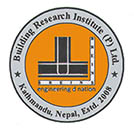
Today (NST)
Monday, Jun 16, 2025
Smart Search
Please post in your Technical Queries, Comments & Suggestions to Contact us......
Advertisement

For Advertisement
|
|
| Subscribe to BREINS Sci-Tech |
| Visit this group |

Material Testing
Tensile strength is an important property of concrete because concrete structures are highly vulnerable to tensile cracking due to various kinds of effects and applied loading itself. However, tensile strength of concrete is very low in compared to its compressive strength.
Due to difficulty in applying uniaxial tension to a concrete specimen, the tensile strength of the concrete is determined by indirect test methods: (1) Split Cylinder Test (2) Flexure Test.
It should be noted that both of these methods give the higher value of tensile strength than the uniaxial tensile strength.
Split-Cylinder Test
It is the standard test, to determine the tensile strength of concrete in an indirect way. This test could be performed in accordance with IS : 5816-1970.
A standard test cylinder of concrete specimen (300 mm X 150mm diameter) is placed horizontally between the loading surfaces of Compression Testing Machine (Fig-4). The compression load is applied diametrically and uniformly along the length of cylinder until the failure of the cylinder along the vertical diameter. To allow the uniform distribution of this applied load and to reduce the magnitude of the high compressive stresses near the points of appplication of this load, strips of plywood are placed between the specimen and loading platens of the testing machine. Concrete cylinders split into two halves along this vertical plane due to indirect tensile stress generated by poisson's effect.
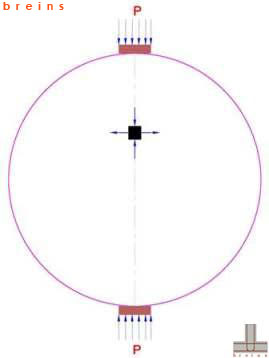
Fig-4 (Splitting Tensile Strength Test : Cylinder with compression loading along the vertical diameter)
Due to this compressive loading, an element lying along the vertical diameter of the cylinder is subjected to a vertical compressive stress and a horizontal stress (Fig-4). The loading condition produces a high compressive stress immediately below the loading points. But the larger portion of cylinder, corresponding to its depth is subjected to uniform tensile stress acting horizontally. It is estimated that the compressive stress is acting for about 1/6 depth and the remaining 5/6 depth is subjected to tension due to poisson's effect.
Assuming concrete specimen behaves as an elastic body, a uniform lateral tensile stress of ft acting along the vertical plane causes the failure of the specimen, which can be calculated from the formula as,
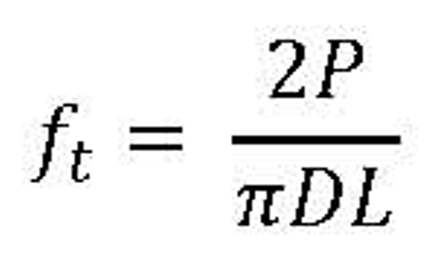

The above test result represents the "Splitting Tensile Strength" of concrete that varies between 1/8 to 1/12 of the cube compressive strength.
Flexure Test
After the Splitting tensile test another common test performed for determination of tensile strength is the Flexure test.
The test could be performed in accordance with as per BS 1881 : Part 118 : 1983. A simple plain concrete beam is loaded at one-third span points. Normal standard size of specimen is 150x150x750 mm. If the largest nominal size of the aggregate doesnot exceed 25mm, size of 150x150x500 mm may also be used. Span of the beam is three times its depth.
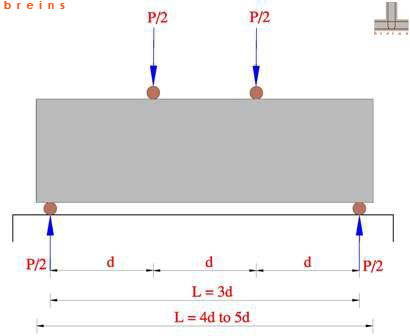
Fig-5 (Flexure Tensile Strength Test : Beam with two point loading at one-third of its span)
The typical arrangement for the test is shown in Fig-5 above. Equal Loads are applied at the distance of one-third from both of the beam supports. It induces equal reaction same as the loading at both of the supports. Loading on beam is increased in such a manner that rate of increase in stress in the bottom fibre lies within the range of 0.02 MPa & 0.10 MPa. The lower rate being for low strength concrete and the higher rate for high strength concrete.
From the above loading configuration it is clear that at the middle one-third portion, in between two loadings, beam is subjected to pure bending. No shear force is induced within this portion. It is this portion of beam where maximum pure bending moment of Pd/2 is induced accompanied by zero shear force.
As loading increases, if fracture occurs within the middle one-third of the beam, the maximum tensile stress reached called "modulus of rupture" fbt is computed from the standard flexure formula,
![]()
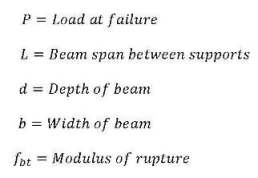
If fracture takes place outside the middle one third, then, according to BS 1881 : Part 118 : 1983, the test result should be discarded.